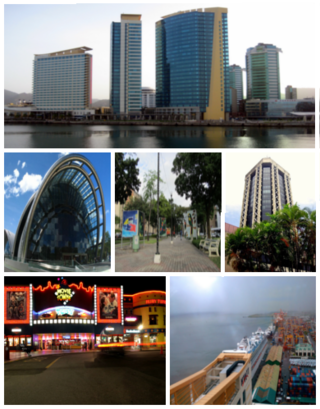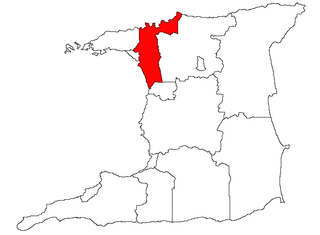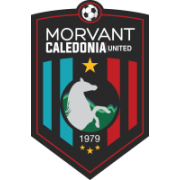
Morvant (pronounced, in the local English dialect, "mor-vuh") is a community in Trinidad and Tobago located east of Port of Spain and west of Barataria.

Morvant (pronounced, in the local English dialect, "mor-vuh") is a community in Trinidad and Tobago located east of Port of Spain and west of Barataria.
Morvant is located in the southern foothills of the Northern Range of the island of Trinidad. It is bordered by the Lady Young Road on the North and penetrates the communities of Mon Repos on the North East, Barataria on the East, Laventille on the South West and Belmont on the West.
Morvant was originally a village that housed many working-class families who made their livelihoods within the homes and businesses of the (relatively) more affluent middle-class people living in the nearby capital city of Port of Spain. There are still many older Trinidadians who can remember and tell the stories about how, in the late 1940s and early 1950s—long before the political advent of Eric Williams and the PNM—the Trinidad government undertook in Morvant an innovative community-based housing development program that brought greater prosperity and stability to Morvant. The program was patterned on the community development and housing strategy that was being used in Puerto Rico and, some years later, was used in Cuba. Through this program, the government solicited the interest of several Morvant families and encouraged them to assist one another in restoring older homes and in building new homes in Morvant. As a result of this housing development approach, many new families joined the older Morvant residents and came to belong and strengthen this vibrant, resourceful and proud working-class community.
As has happened within other older communities in Trinidad and Tobago, the Morvant community has long outgrown its original borders. Today, it is a sprawling area that has gained negative focus due to pockets of criminal activity and increased media reporting that gains greater publicity by focusing on crime and calamity. Statistically however, the levels of reported crimes seem lower than that of other area of similar population density in the country. And this may well be attributed to Morvant's historical development.
Mainly because of its proximity to Port of Spain and more than likely also due to its innovative community development history, Morvant has a reliable supply system of basic amenities i.e. water, electricity and sanitation services. Public transport is quite prompt and there are free Early Childhood Learning Centres next to most primary schools - all of which are funded by the government. Health care has improved as the health centre was relocated and facilities were upgraded.
In Morvant recreational facilities are quite satisfactory, there are numerous basketball courts in the area and there is a recreational ground where the youths can play football or practice athletics. Much of the country's traffic passes through Morvant as one of Trinidad's major roads runs through here (Lady Young Road). It is used as an alternative route to Port-of-Spain; Trinidad's capital city. Also, because of Morvant's convenient location near to the capital city, most of the children who reside in Morvant can attend school in the capital or in the neighbouring suburbs such as Belmont.
Trinidad and Tobago, a country that relies heavily on industrialisation and tourism, has various transport systems.

Port of Spain, officially the City of Port of Spain, is the capital of Trinidad and Tobago and the third largest municipality, after Chaguanas and San Fernando. The city has a municipal population of 37,074, an urban population of 81,142 and a transient daily population of 250,000. It is located on the Gulf of Paria, on the northwest coast of the island of Trinidad and is part of a larger conurbation stretching from Chaguaramas in the west to Arima in the east with an estimated population of 600,000.

The Borough of Chaguanas is the largest municipality and fastest-growing town in Trinidad and Tobago. Located in west-central Trinidad, south of Port of Spain, north of Couva and San Fernando, and named after the indigenous tribe who originally settled there, it grew in size due to its proximity to the Woodford Lodge sugar refinery. It remained a minor town until the 1980s when it began to grow rapidly as it drew people for its bargain shopping and moderately priced housing. Its rapid growth has seen property values increase dramatically, however.

Chaguaramas lies in the Northwest Peninsula of Trinidad west of Port of Spain; the name is often applied to the entire peninsula, but is sometimes used to refer to its most developed area. The developed area in Chaguaramas starts at ALCOA and ends at the Army and Coast Guard camps on the mainland. In the description or context of "developed area" one excludes the five islands which are in various stages of development or redevelopment as of 2016.

Laventille is a ward of Trinidad and Tobago.
Couva is an urban town in west-central Trinidad, south of Port of Spain and Chaguanas and north of San Fernando and Point Fortin. It is the capital and main urban centre of Couva–Tabaquite–Talparo, and the Greater Couva area includes the Point Lisas Industrial Estate and the Port of Point Lisas. It is one of the fastest-growing towns in the country. Couva's southern boundary is at the village of California & Point Lisas, and to the north Couva stretches to McBean. To the east of Couva is Preysal. To the west of Couva is the road to Waterloo and Carli Bay, which are located on the Gulf of Paria. Couva was part of the Caroni County. Couva is considered a major power base for the United National Congress (UNC), whose headquarters was previously located here.

Barataria is a town in Trinidad and Tobago. It is east of Port of Spain and Laventille and west of San Juan. It is part of the East–West Corridor.

San Juan is a town in Trinidad and Tobago. Located in San Juan–Laventille region in Saint George County, it lies within the East-West Corridor Metropolitan Area, between Barataria and Saint Joseph.

The East–West Corridor is the built-up area of north Trinidad stretching from the capital, Port of Spain, 24 kilometres (15 mi) east to Arima. The term was coined by economist and political philosopher Lloyd Best, after gleaning the works of a technocrat named Lynette Attwell. The Corridor includes such towns as Laventille, Morvant, Barataria, San Juan, St. Joseph, Curepe, St. Augustine, Tunapuna, Tacarigua, Arouca, and Five Rivers, once distinct communities, now districts within a continuous urban area. For the most part it runs along the Eastern Main Road, between the Churchill–Roosevelt Highway and the foothills of the Northern Range. It is a densely populated and fairly congested strip of development along some of the best agricultural soils in the country.

Diego Martin is a town and is the urban commercial center and capital of the Diego Martin region in Trinidad and Tobago. Its location in the region is just on the south eastern border, west of the capital city of Port of Spain and east of the town of Carenage. Diego Martin town in the Northern Range was once filled with a number of small valleys but is now a densely populated area. It was named after a Spanish explorer Don Diego Martín. The area was settled by French planters and their slaves in the 1780s. It consists of a cluster of communities including Congo Village, Diamond Vale, Green Hill, Patna Village, Petit Valley, Blue Range, La Puerta Avenue, Four Roads, Rich Plain, River Estate, Blue Basin, Water Wheel, West Moorings, Bagatelle and Sierra Leone.
The Churchill–Roosevelt Highway, sometimes refers to as CRH, is the major east–west highway on Trinidad island in Trinidad and Tobago.

San Juan–Laventille is a region of Trinidad. It has a land area of 220.39 km². The San Juan–Laventille Regional Corporation is headquartered at MTS Plaza in Aranguez, San Juan. Other urban areas include Barataria, Laventille, Morvant and San Juan. It is the smallest region in Trinidad. The region is bordered by Port of Spain in the west to St. Joseph in the east.

Morvant Caledonia United is a professional football team in Trinidad and Tobago's top-level TT Pro League. It is based in Morvant; its home stadium is Hasely Crawford Stadium.
The Lady Young Road is a major roadway in Trinidad and Tobago linking the Eastern Main Road in Barataria to the Queen's Park Savannah in Port of Spain. It is also an important connector between the Churchill-Roosevelt Highway and uptown Port of Spain.
General elections were held in Trinidad and Tobago on 5 November 2007. Nomination day was 15 October. Five parties contested the elections; the ruling People's National Movement, the official opposition United National Congress–Alliance, the Congress of the People, the Tobago United Front–Democratic Action Congress and the Democratic National Assembly. Five independent candidates also ran.

Westmoorings is a residential area in the region of Diego Martin on the island Trinidad, west of Port of Spain, the capital of Trinidad and Tobago. This suburb consists of mainly lower middle class to upper-class families and is generally known throughout the country for its upscale housing and expatriate population. This area mainly consists of small apartments and large upscale houses. It also has a few offshore moorings, a mall, a government college, the International School of Port of Spain, and a private primary school, Dunross Preparatory School. It is bordering the sea and Diego Martin river.
Lange Park is the oldest planned premium residential community in Chaguanas, Trinidad and Tobago.

Belmont, in north-east Port of Spain, in the Republic of Trinidad and Tobago, is located at the foot of the Laventille Hills; it was the city's first suburb. In the 1840s–'50s, parts of the area were settled by Africans rescued by the Royal Navy from illegal slaving ships. In the 1880s–'90s, the population swelled rapidly, and the characteristic Belmont street pattern of narrow, winding lanes developed. The black professional class built large homes in Belmont, as they were excluded from the more expensive neighbourhoods such as St. Clair and Maraval; Belmont became known as "the Black St. Clair". Many of these large homes have been renovated and converted to business use, but some remain in family hands. Belmont currently is a lower-middle to middle-class residential neighbourhood. It was the birthplace and early home of many important Carnival designers and bandleaders. Belmont has 9,035 inhabitants.